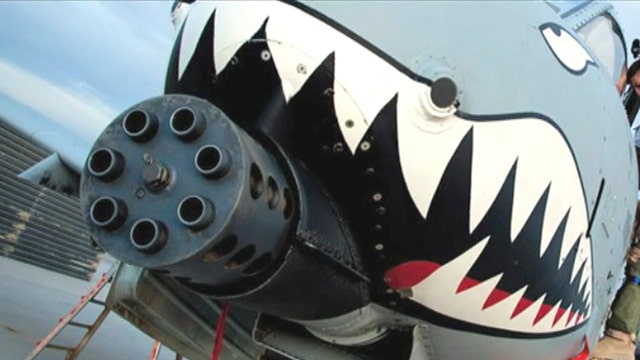The Air Force's venerable A-10 Thunderbolt II is proving as impervious to Pentagon cuts as it is to the bullets of the ISIS terrorists who scatter like roaches when the fighter plane known as the "Warthog" bears down on them.
Once again, the deadline for retiring the versatile plane has been pushed back, this time to 2022, when it would be replaced by F-35 Joint Strike Fighters. While the F-35 rollout has been less than smooth, the real reason the Warthog keeps avoiding mothballs is that it is perfect for raining fire down on desert-dwelling Islamic extremists.
“It has consistently proven its worth in the past decade and a half,” said Omare Lamrani, a military analyst with global intelligence firm Stratfor.
The A-10 may lack the speed and graceful lines of other fighter jets, but it is extremely low maintenance, flies low, can practically hover over a battlefield, land almost anywhere and packs a 20-foot-long, 2.5-ton, seven-barrel Gatling gun that can fire more than 1,100 rounds of 30-mm. bullets.
Given that most of the U.S. air power is currently used in the Middle East, the A-10 -- which has not been manufactured for decades -- is the right aircraft for the job, say experts.
“It’s a very old plane, but definitely one of the most capable,” Lamrani said. “The U.S. Air Force has been moving toward multi-mission aircraft, but when it comes to this particular mission this plane is unrivaled in its ability."
“There is no weapon in our arsenal that offers more effective close-air support to American ground troops serving in harm’s way than the A-10 aircraft,”
First designated for retirement in 2011, a planning document the Air Force published in mid-February reveals that 2022 is the flying branch's newest deadline for the last A-10 flight. The extension was announced by Secretary of Defense Ash Carter during a preview of the Pentagon’s budget at the Economic Club of Washington, D.C. according to the Arizona Daily Star.
The venerable plane, first built for destroying Soviet tanks, has been on the chopping block since the sequester of 2011 mandated steep cuts in the Pentagon budget. Although the planes haven't been built in more than 30 years, the Department of Defense believes it can save maintenance costs by phasing them out.
Air Force brass believes newer, faster aircraft like the F-16, F-15E, and, eventually, Lockheed Martin’s F-35 can do a better job of the Warthog’s mission of providing close air support to soldiers on the ground. But the Pentagon disagrees and has pushed back, leading to Air Force brass to extend the end date for a phase out.
The plane has survived year-to-year, with powerful lawmakers such as Senate Armed Services Committee Chairman John McCain, R-Ariz., fighting to keep it alive.
“There is no weapon in our arsenal that offers more effective close-air support to American ground troops serving in harm’s way than the A-10 aircraft,” McCain said in a statement released earlier this month. “I look forward to seeing our A-10 pilots continue to make important advances in the fight against ISIL in the Middle East, boosting NATO’s efforts to deter Russian aggression in Eastern Europe, and supporting vital missions for U.S. national security wherever they are needed.”
The Air Force has been itching to junk the plane for years, with some speculating that top brass believes the A-10 bucks the embraced strategy of high-altitude strategic bombing. The Pentagon believes it can save $4.2 billion in operation and maintenance costs over five years by retiring all 283 of the Air Force’s A-10s, the last of which rolled off Fairchild Republic’s assembly line in 1984.
Lamrani points out that the replacement could actually prove to be more costly.
“The F-35 is very expensive,” he said. “They need to work toward a strong replacement, but they do not have any strong plans in place.”






















